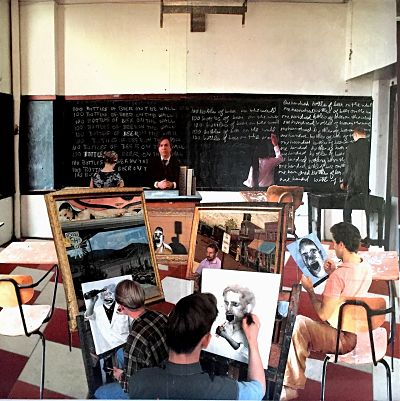
Could Somebody Please Open One of Those Damn Bottles and Give It to Me
October 2016. There seems to be agreement that something is in the way, removal of this something is desirous, and the means is some variation of distortion, subversion, violence, catastrophe or chance.
The apparent goal is reality, the nervous system, sensation, emotion and feeling. The veil, cliche. The response, rage resulting in (see above).
I flip through an art magazine. Talk about rage. Every artist is either interrogating, blurring the lines, subverting, obscuring or disrupting. Take Albert Oehlen, the leading proponent for Bad Painting. The reviewer in Art in America, December 2004, writes: Oehlen taunts the viewer.., barrages the viewer…, obscures the imagery. The works are train wrecks of visual incident. They look like they were painted as the artist was falling down a flight of stairs.
The brutality of fact is what the artist Francis Bacon is after, often engaging in what he calls free marks (throwing a can of paint at the canvas is one example). He wants his subject’s reality, essence. The facts. Wants to sidestep the veil and translate directly to the viewer’s nervous system. Understanding isn’t required, clarity is destroyed, storytelling hardly tolerated. Rather, disruption and violence.
I want to say that art generally, naturally is about this sort of thing. It’s not. Or…hasn’t been historically. Instead art has been concerned with traditional aesthetics. When Dadaism came along, it was labelled anti-art because its purpose was to offend, call into question the reason and logic of bourgeois society and embrace chaos and irrationality in protest. One of its spokesmen said: For us, art is not an end in itself but is an opportunity for the true perception and criticism of the times we live in.
My collage starts with a dream image of a small number of people writing lines on a blackboard. 100 bottles of beer on the wall. 100 bottles of beer on the wall. Elsewhere people are working on their art, painting images of statues. I don’t much care for the idea of painting images of statues. Seems redundant.
I’ve just read Anne Carson’s translation of ‘Agamemnon’ by the Greek tragedian Aeschylus. In her introduction she speaks of Bacon as being a huge fan of Aeschylus because, according to Bacon, their ends are the same. What Aeschylus did with language, Bacon does with paint. I learn that Bacon painted a triptych inspired by Aeschylus’ trilogy, An Oresteia. I‘m tempted to put a version of it in my collage as I have a few canvases to fill. Bacon’s triptych is too raw though. Messes with my nervous system. I can’t help it, the entrails bother me.
It’s good to think about cliche. Hannah Arendt does. In her book ‘Thinking: The Life of the Mind’ she writes: Clichés, stock phrases, adherence to conventional, standardized codes of expression and conduct have the socially recognized function of protecting us against reality, that is, against the claim on our thinking attention that all events and facts make by virtue of their existence. That being the case, it’s not a bad idea to rage against cliche. I suggest this to my partner who says…that’s just another cliche.
I still want to use Bacon in my collage. I like his study of the screaming pope. It’s taken from Velazquez’s Portrait of Pope Innocent X. Bacon’s idea is to get at the inside of the scream. My idea is to provide some relief for the screamer. I don’t know about giving a beer to the pope in public but I’ve disguised him (small sketch on the left). And I figure he could use one. A question though: what’s he got to rage about?